SaaS SEO Checklist
Step by step checklist to grow your SaaS search engine optimization. Develop your software brand's online presence to attract high quality traffic and leads with high ranking keywords in Google search.

SEO Checklist Structure

This checklist has been developed by
Christopher Lier
Google-certified SEO Specialist, Co-Founder LinkPanda, SaaS Co-Founder
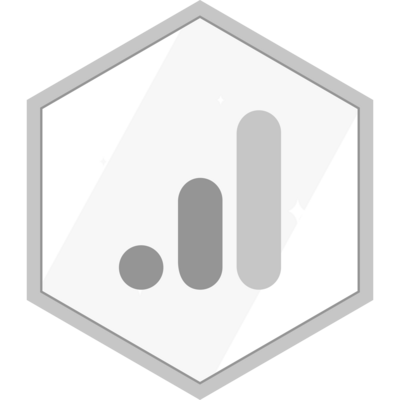
The SEO Components Explained
Before we start going into the checklist, here is a little background information on the different SEO components.
Strategy
Planning your SEO strategy is absolutely crucial because SEO requires a 6-12 month horizon. Spend enough time on goal setting, strategy and tool set-up.
Tracking
Define your key metrics that matters most in relation to your goals. This could be total website traffic, organic traffic, domain rating or leads generated.
Content Strategy
Content marketing is the backbone of SEO and arguably responsible 50% or more of your SEO results. Plan your content production based on search demand and audience data.
On-Page SEO
On-Page optimization refers to the optimization of content considering various factors that Google and other search engines pay attention to. This includes images and keyword optimization and internal linking.
Technical SEO
Technical SEO is also an important aspects of search engine optimization strategy. Factors involve page speed, accessibility, mobile responsiveness, code optimization and crawlability for search engines.
Content Marketing
Content marketing is closely linked to your content strategy and is the execution, involving writing and optimization of existing content. Focus on both blog posts and product pages.
Link Building
Link building is the process of growing domain authority with the acquisition of incoming link mentions. Links are the fuel for SEO without which your site simply cannot make big moves and gain traction.
Check
SEO needs a continuous feedback loop. This process involves reviewing your results such as keyword rankings, traffic and backlink profile and making continuous adjustments.
You can also download our SaaS SEO Checklist here
1. Strategy
Your SEO work should start by examining your current performance, no matter where you stand. Get a clear understanding of the most important metrics and strategies deployed.
Begin by assessing your current SEO performance using a set of key metrics that will provide a comprehensive overview of where your website stands. Start with Domain Rating (available through tools like Ahrefs.com), which reflects the overall strength of your domain’s backlink profile and its potential to rank in search engines. Next, analyze your Total Monthly Traffic to understand the volume of visitors your site is attracting. Complement this with insights from New User Monthly Traffic (accessible via Google Analytics), which will give you a clearer picture of how well you’re drawing in fresh, potential customers. Lastly, evaluate your Keywords Ranking on Page 1 (using Google Search Console) to identify which terms are already performing well and generating visibility, helping you target areas for further optimization.
Remember the following rule: You can’t manage what you can’t measure. So start out by making sure you understand your starting situation inside out.
After assessing your starting position, start defining what you want to achieve with your SEO strategy. Defining macro goals means that you set your 1-4 most important targets that you want your website to hit over a longer-term horizon (6-12 month or beyond).
Establishing macro goals is crucial for steering your SEO efforts toward long-term success. Begin by setting milestone goals that will serve as benchmarks for evaluating your progress over time. Focus on several critical metrics:
Traffic: Set specific targets for both Total Traffic and New User Traffic to ensure you’re not only retaining your existing audience but also continuously attracting new visitors to your site. This helps in expanding your reach and driving overall growth.
Keywords on Page 1: Identify key keywords that are crucial for your business and aim to secure Page 1 rankings for them. Achieving and maintaining top positions in search results is essential for maximizing visibility and organic traffic.
Domain Rating: Set a goal to consistently improve your Domain Rating by building high-quality backlinks and strengthening your site’s authority. A higher domain rating is indicative of a strong online presence and a higher likelihood of ranking well across various keywords.
Conversions: Finally, establish targets for Conversions, whether they are measured in terms of leads generated or sales completed. This metric is a direct indicator of how effectively your SEO efforts are translating into tangible business results.
To ensure consistent progress and maintain momentum in your SEO strategy, it’s vital to set micro goals that break down your macro objectives into manageable, short-term targets.
Focus particularly on New User Traffic and Conversions, as these metrics directly correlate with expanding your customer base and driving revenue.
New User Traffic: Aim for a 5%-10% monthly increase in new visitors to your website. This steady growth rate is both ambitious and achievable, fostering continual improvement without overwhelming your resources. Utilize a simple spreadsheet to track these figures month-over-month, allowing you to visualize trends, identify patterns, and adjust strategies as needed.
Conversions: Parallel to traffic goals, set specific monthly targets for conversions, whether they manifest as lead captures, product purchases, or service sign-ups. Monitor the conversion rate to ensure that as traffic increases, the quality and engagement level of your visitors remain high.
By meticulously tracking these monthly goals in a spreadsheet, you create a feedback loop that informs your ongoing SEO tactics, enabling timely adjustments and fostering a data-driven approach to achieving your overarching business objectives.
Deliverable goals define output-related targets. These are goals that require actions instead of just focusing on the end result. Practically, we are speaking about how much content you need to produce and how many link mentions you need to build to take active steps towards SEO success.
Blog Posts Created Per Month: Set a goal to produce and publish between 1 to 4 high-quality blog posts each month. This range ensures that your content strategy remains active and fresh, providing regular opportunities to target new keywords, engage your audience, and demonstrate thought leadership in your industry. Regular content updates also signal to search engines that your site is active and relevant, which can positively impact your rankings.
Backlinks Built Per Month via Guest Posting: Establish a monthly target of acquiring at least 3 to 4 high-quality backlinks through guest posting on authoritative websites. Guest posting not only helps in building valuable backlinks that enhance your site’s domain authority, but it also increases your brand’s visibility across a broader audience. Aim for backlinks from reputable sites within your niche to ensure they provide maximum SEO value and contribute positively to your overall link profile.
Setting and consistently hitting these benchmarks will keep your content and link-building efforts on track, leading to sustained improvements in your SEO performance over time.
To effectively implement your SEO strategy, assign clear responsibilities within your team:
Content Creation: Appoint a team member to manage the creation and publishing of 1 to 4 blog posts per month. This person will handle topic research, content development, and scheduling to ensure consistency.
Link-Building: Designate an individual to oversee acquiring 3 to 4 high-quality backlinks per month. They will identify guest posting opportunities, manage outreach, and track backlink effectiveness.
KPI Tracking: Assign someone to monitor and report on key performance indicators (KPIs). This role involves reviewing traffic, conversions, and other metrics, and providing regular updates to the team.
Clear responsibility ensures each goal is met effectively and aligns with your overall SEO objectives.
Tools to use in the SEO strategy phase
Google Analytics is a powerful tool for SEO planning and goal setting as it provides detailed insights into website traffic, user behavior, and conversion metrics, enabling you to track performance, identify trends, and refine strategies to achieve specific SEO objectives.
Google Search Console is a valuable tool for monitoring and optimizing your website’s search performance, providing insights into search queries, indexing status, and potential issues.
Google Sheets is an excellent tool for documenting and tracking your SEO goals, allowing you to organize macro goals such as overall traffic and keyword rankings, as well as monthly targets like specific traffic increases and conversion metrics. You can use use it to understanding past and current SEO performance before setting your milestones and targets.

2.Tracking
Measuring results is fundamental to succeed in your Search Engine Optimization (SEO) program. Setting up the important tools and systems right from the start will make a difference in understanding results, for your team and management.
Google Search Console is one of our favourite SEO tools because it provides data straight from the source of Google. You can see your overall SEO performance trends, understand differences in grows/drops in clicks and impressions on both high-level (domain) and detailed level (individual keywords/pages). Also, you can see exactly which pages are indexed or rejected for indexing by Google.
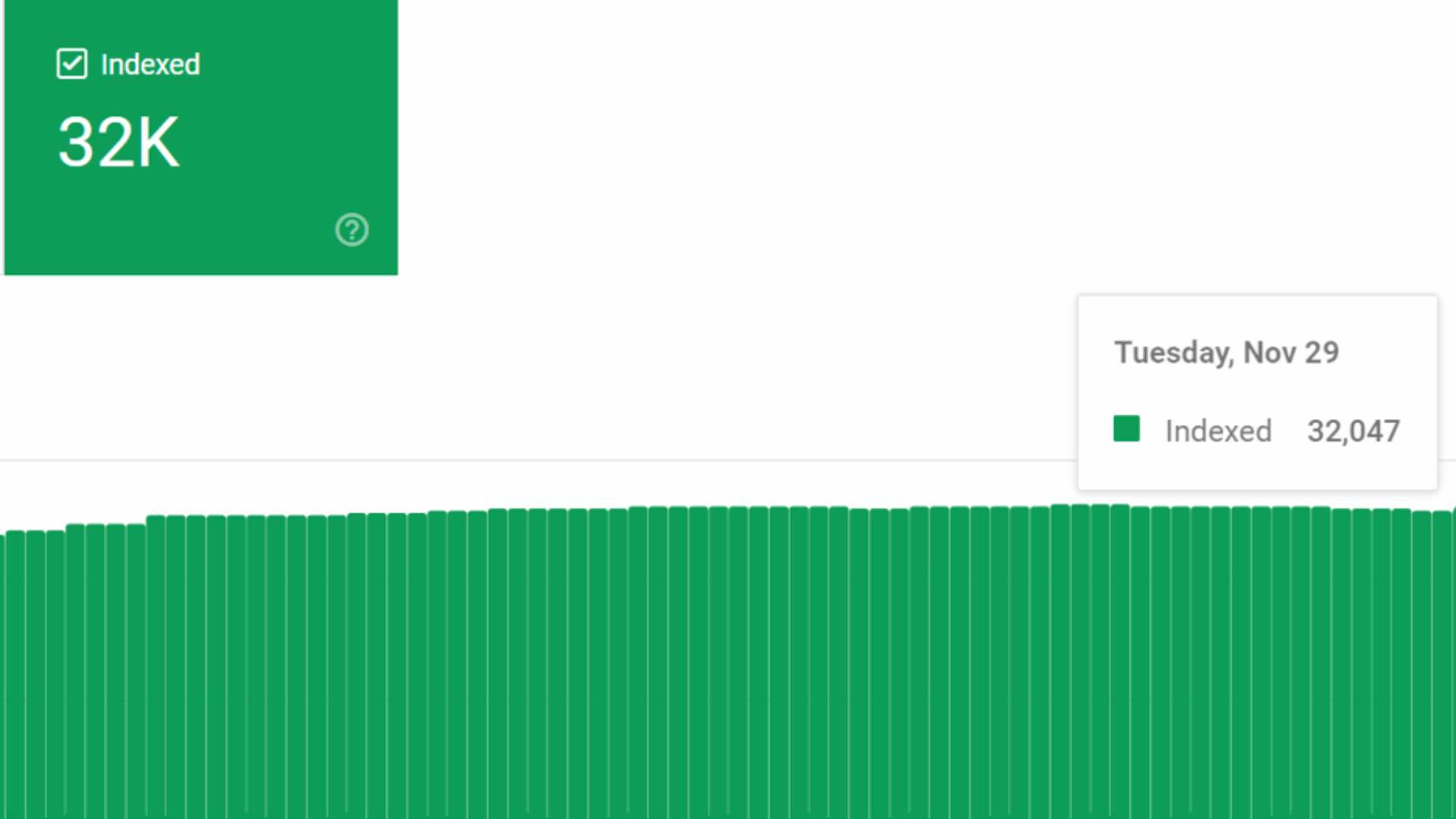
Indexed pages report in Google Search Console
Set up Google Search Console for your domain to gain valuable insights into your site’s search performance. If it’s already set up, ensure it is correctly configured and actively recording crucial search data, such as search queries, indexing status, and potential issues. This tool helps you monitor how your site appears in search results, understand user interactions, and identify opportunities for optimization to enhance your SEO strategy.
Your Google Analytics set-up should involve the set-up of website views and conversion goals & events.
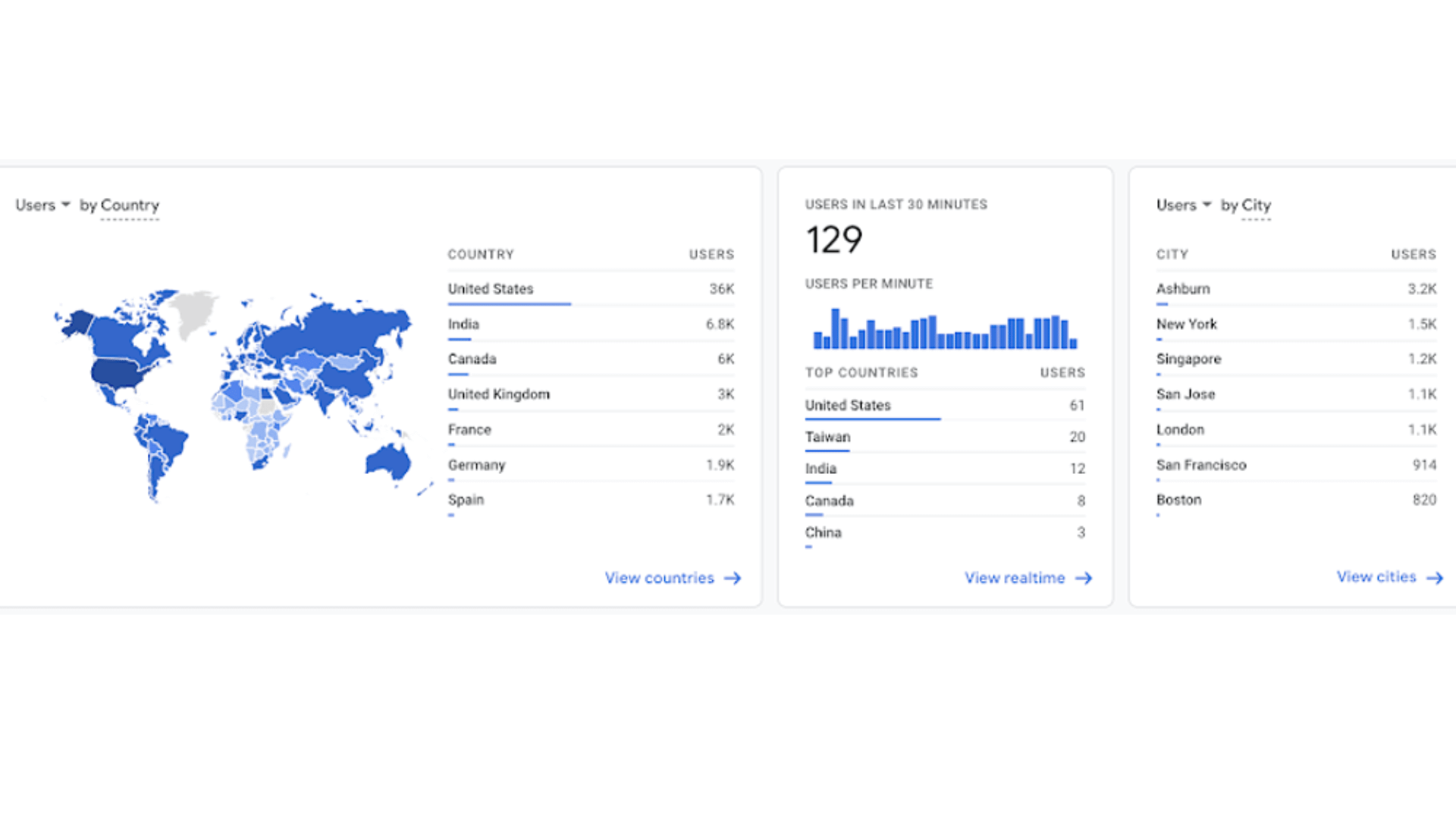
Google Analytics live visitor data and geograpahic user insights
Fundamentally, a view is a specific set of data that you can access and analyze for a particular aspect of your website or app. In short, it defines what URLs and/or sub domains are in scope or out of scope to produce the data. Conversion goals define specific actions that indicate a significant event with sales relevance, such as new lead submissions, contact form inquiries, e-commerce sales, or SaaS user registrations.
Set up Google Analytics for your website to track and analyze visitor behavior effectively. Ensure that it is properly configured and accurately recording key metrics such as traffic volume and pageviews. To maintain data integrity, add IP filters to exclude traffic from internal team members, ensuring that the analytics data reflects genuine user interactions. Navigate to Admin > Account Settings > All Filters to set up and manage these filters, helping you obtain more accurate insights and make informed decisions based on external user behavior.
Setting Up Conversion Goals in Google Analytics
Log in: Go to Google Analytics and select your GA4 Property.
Navigate to Events:
- Click on Configure in the left-hand menu.
- Select Events.
Create or Mark an Event:
- To create a new event, click Create Event and configure the details, including the event name and parameters.
- To mark an existing event as a conversion, find the event you want to track and toggle the Mark as conversion switch.
Define Event Parameters (if creating new):
- Enter the event name and conditions (e.g.,
event_name = 'purchase'). - Add any necessary parameters to specify what counts as a conversion.
- Enter the event name and conditions (e.g.,
Save Changes: Click Create to finalize a new event or simply toggle the conversion switch for an existing event.
Monitor Conversions: Track your conversions under the Reports section, in Events, or Conversions.
This setup helps you track important actions and measure performance in GA4.
3. Content Strategy
Understanding your target audience is another crucial planning step. Before writing any content for your website, you should have clarity on both audience and search demand. This will help you monetize your search engine optimization by aligning content creation with the exact persona that your website can sell their products and services to.
Start by defining your ideal customers’ demographics, interests, and pain points. Develop personas that include their goals, challenges, and preferred content formats. This focused approach helps tailor your content to meet their specific needs and preferences, ensuring it resonates and engages effectively. Regularly update your personas based on feedback and data to keep your content relevant.
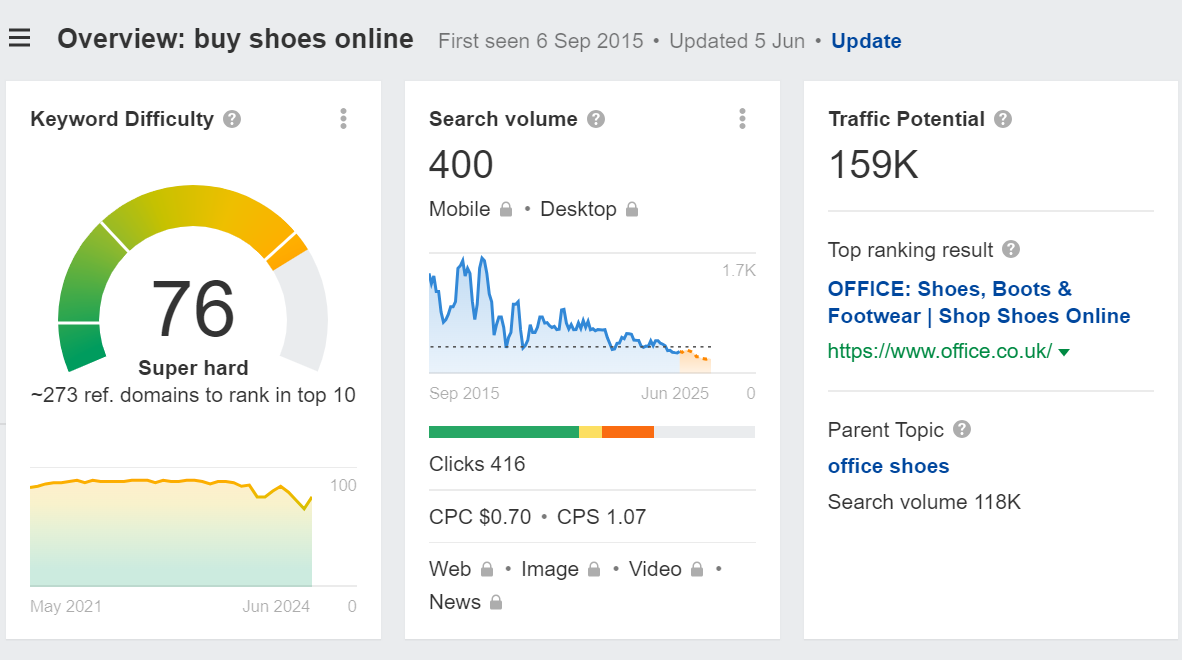
Ahrefs keyword explorer for SEO keyword research
Keyword research is essential for successful SEO, as it determines the quality and relevance of your traffic. The right keywords can drive targeted traffic and improve rankings, while poor choices lead to ineffective results. Follow this 5-step framework for effective keyword selection:
Search Volume: Use tools like Ahrefs or Semrush to find keywords with substantial search volume (ideally over 30 searches per month) to ensure there is sufficient demand.
Keyword Difficulty: Assess competitiveness using tools to find keywords with a difficulty score between 0-30 for easier ranking. Avoid overly competitive keywords initially.
Search Intent: Determine the search intent—whether transactional, informational, or navigational. Focus on keywords with high purchase intent for better conversion potential.
Top 10 Assessment: Analyze the top 10 search results for your target keywords. Check metrics like domain rating and backlinks to evaluate your chances of ranking.
Business Relevance: Prioritize keywords based on their relevance to your business goals and high-priority products or services.
This approach ensures you select keywords that drive meaningful traffic and support your SEO objectives. Also check out the full keyword research guide.
Content marketing is half the game in SEO. Simply put, to rank higher than your competition, you need better content that people are engaged with and reshare and share links to.
Mapping Keywords to Blog Topics:
- Keyword Analysis: Identify and categorize keywords based on relevance and search intent.
- Topic Development: Create blog topics that align with these keywords. For example, use “effective SEO strategies” to inspire a post titled “10 Proven SEO Strategies to Boost Your Rankings.”
- Content Calendar: Schedule blog posts to maintain a steady flow of content.
- Optimization: Integrate keywords naturally into titles, headings, and content.
Why Blogging is Essential for SEO:
- Boost Visibility: Regular blogging increases your site’s presence in search results.
- Target Keywords: Blogs help you rank for a variety of keywords and long-tail phrases.
- Drive Engagement: Quality content encourages user interaction and social sharing.
- Gain Backlinks: Valuable blogs attract backlinks, improving domain authority and ranking.
Tools to use in the content marketing strategy phase
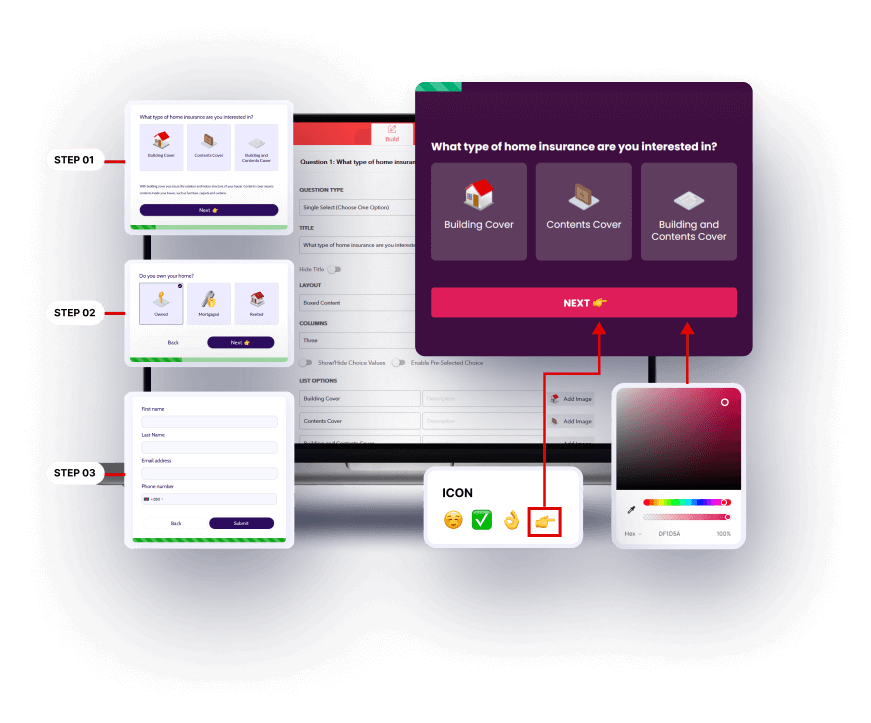
Use flexible form builder software like LeadGen App to create dynamic research and feedback forms. These tools help you effectively collect valuable information from your audience and customers.
Ahrefs is one the leading SEO analytics and research tools. You can make use of Ahrefs to understand SEO keywords and their individual search volume. Also, you can identify keyword competitiveness and reveal your competitor’s top performing keywords, web-pages and more. The tools are very powerful and provide a transparent lense on the search data as well as competitor data.
Google sheet can help you document your ideal customer persona profile, serve as a keyword research sheet as well as a content calendar for upcoming blog post creation. The use cases are enormous, but we would recommend starting with these 3 essential sheets first: Customer persona sheet, keyword research, content calendar.
4. On-Page SEO
On-Page optimization involves refining your blog posts and web pages to align with target search keywords, enhancing their relevance and visibility in search engine results. The goal of On-Page optimization is to ensure your blog posts and web pages deliver the most relevant and high-quality answers for the keywords users enter into search engines like Google.
- Meta Titles and Descriptions: Ensure each page has a unique meta title and meta description, incorporating relevant keywords.
- Header Tags: Use one H1 tag per page for the main title and multiple H2, H3 tags for subheadings to structure content.
- Content Length: Increase low word count pages to a minimum of 300 words for pages and 500 words for posts.
- Image Optimization: Ensure all images are under 500 KB and include alt and title attributes, touching on or including exact keywords.
- Internal Links: Add 5-10 internal links per page and ensure there are at least 3 incoming links from other pages.
- Sitemaps: Create and update Sitemap.xml, HTML sitemap, and Image sitemap.
- Robots.txt: Verify that the robots.txt file is set up correctly.
- SSL Certificate: Confirm that your website has an SSL certificate for secure browsing.
Effective lead generation and user journey optimization are crucial for SaaS businesses aiming to convert website visitors into qualified leads. By strategically integrating lead forms and optimizing the user experience, you can maximize conversions and enhance the overall effectiveness of your SEO efforts. Ultimately, you not only want more traffic but SaaS sign-ups, right?
SaaS Sign-Up Forms: Implement prominent sign-up forms for trials or demonstrations on key pages, such as your homepage and dedicated landing pages. These forms should be simple and inviting, encouraging visitors to start their free trial or request a demo with minimal friction.
Multi-Step Contact Forms: Develop a multi-step contact form on your main contact page to improve lead capture. Begin with questions about service requirements to qualify leads, followed by fields for messaging and contact details. This method engages users more effectively and collects valuable information before submission.
Lead Magnets and Capture Forms: Integrate lead magnets and capture forms throughout your site and blog posts. Offer valuable resources like calculators, downloadable guides, or exclusive content.
Ongoing content optimization ensures your existing blog posts and pages stay relevant and perform well in search results. This process involves regular updates based on performance metrics and user feedback. Arguably, the ongoing revisiting of existing pages and finetuning them is even more important than only focusing on new content creation.
Steps for Ongoing Optimization:
Analyze Performance:
- Google Search Console: Review performance metrics like impressions, clicks, and average position. Identify underperforming content or keywords with potential for improvement.
- Ahrefs: Track keyword rankings and backlink profiles. Look for changes in keyword performance and opportunities to enhance content.
Content Refinement:
- Update Content: Revise blog posts to address content gaps, add new information, and incorporate trending keywords. Ensure the content aligns with current search intent and provides value.
- Enhance User Experience: Improve readability, add multimedia elements, and optimize internal linking to enhance user engagement and navigation.
Follow SEO Best Practices:
- SEO Checklist: Use the SEO checklist to verify that all optimization aspects are covered, including meta tags, headings, and image optimization.
Request Recrawl:
- Submit a recrawl request in Google Search Console to ensure that updated content is indexed promptly.
Monitor and Adjust:
- Revisit performance metrics after two weeks to assess the impact of changes. Adjust strategies based on data, and continue to review and optimize content regularly to maintain and improve search rankings.
This iterative process helps maintain content relevance and effectiveness, ensuring sustained SEO performance.
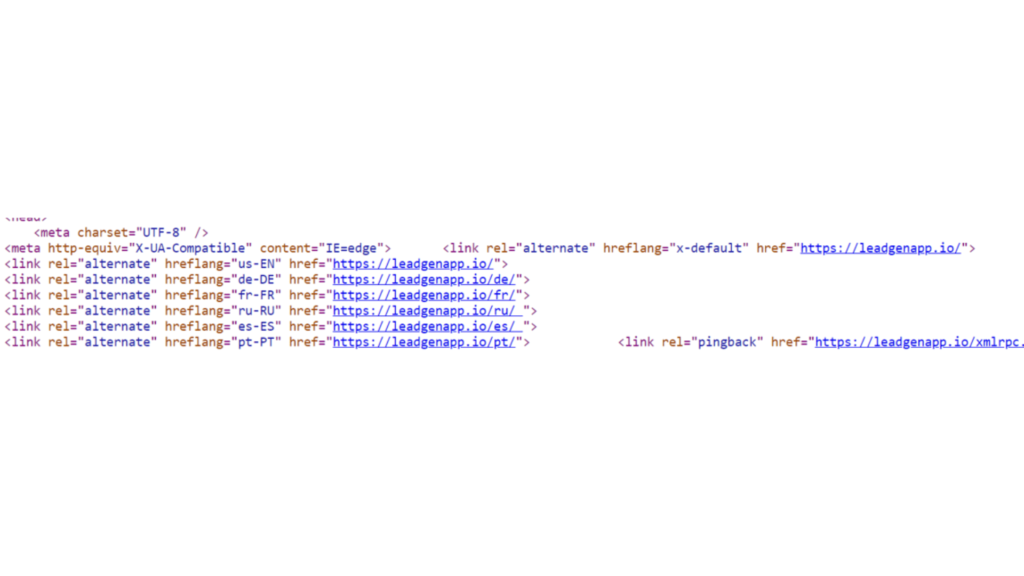
Hreflang code set-up in website source. It’s not strictly necessary but a good practice for multi-lingual SaaS sites.
5. Technical SEO
Technical SEO involves a variety of factors that are affecting your site's performance. Key factors include improving page speed, optimizing code structure, ensuring accessibility, and refining overall site architecture.
Addressing technical issues is crucial for maintaining a healthy site and improving search visibility. The general technical SEO involves:
5.1 Fixing errors and optimal website for technical factors:
● Fix 404-page errors: Update links leading to 404 URLs if you have the option to change it, add 301 redirects for broken links outside your control
● Remove duplicate pages and pages that have no use
● Remove or update links to HTTP URLs on your domain and to external sites.
● Block irrelevant pages from indexation via robots.txt
● Check 3XX redirects: Delete obsolete ones, make sure relevant redirects work.
● Make sure website is easily accessible, loads fast and is
user-friendly on all devices (web, tablet, phone).
Ensuring your website loads quickly is crucial for both user experience and SEO. Slow-loading pages can frustrate users, lead to higher bounce rates, and negatively impact your search engine rankings. To maintain a fast and efficient website, follow this checklist for optimizing page speed:
- Analyze Load Time: Use tools like Google PageSpeed Insights to assess your website’s current load time and identify areas for improvement.
- Optimize Images: Compress images to reduce file size without compromising quality. Use formats like WebP for better performance.
- Minify CSS, JavaScript, and HTML: Remove unnecessary characters, whitespace, and comments from code to decrease file sizes and improve loading speed.
- Enable Compression: Use Gzip or Brotli compression to reduce the size of your CSS, JavaScript, and HTML files sent from your server.
- Improve Server Response Time: Ensure your server is optimized and capable of handling requests efficiently. Consider upgrading your hosting plan if necessary.
- Implement a Content Delivery Network (CDN): Distribute content across multiple servers globally to reduce latency and speed up delivery to users.
- Optimize Web Fonts: Limit the use of custom fonts and ensure they are loaded efficiently to avoid performance bottlenecks.
Core Web Vitals (CWV) are a framework that lays Google’s criteria and best practices to page load time, user-friendliness, accessibility and more related factors. In its essence, it’s a testing protocol of 3 factors:
- Largest Contentful Paint (LCP)
- First Input Delay (FID)
- Cumulative Layout Shift (CLS)
Largest Contentful Paint (LCP): LCP measures the time it takes for the main content of a page to load, providing insight into the perceived loading speed. Ideally, this should happen within 2.5 seconds of the page starting to load.
First Input Delay (FID): FID quantifies the time it takes for a page to respond to the first user interaction, such as clicking a link or tapping a button. A good FID is under 100 milliseconds, indicating that the page is interactive and responsive.
Cumulative Layout Shift (CLS): CLS measures the visual stability of a page by tracking how often elements on the page unexpectedly shift as it loads. A low CLS score (ideally less than 0.1) ensures that users don’t experience frustrating movements of content.
Together, these Core Web Vitals form a critical part of Google’s ranking algorithm, meaning that optimizing them can not only improve user satisfaction but also boost your site’s visibility in search engine results.
While Core Web Vitals are often hard to get right and require detailed expertise in this more technical field, they are proven to make a substantial impact on rankings and search impressions. The trend in SEO goes towards higher prioritization of speed and user experience standards on all device types.
6. Content Marketing
Deploy content marketing strategy and optimize new content posts for SEO (Step 4: On-Page). This step involves the content writing, the execution on the content calendar strategy we focused on earlier. Writing new, long-form blog content based on the keywords identified is a must-have to have chance to gain significant search visibility.
Remember the golden rule of SEO content marketing when writing your content:
Average content no longer works.
In essence, do a much better job in terms of matching keyword search intent, content uniqueness and in content depth than the currently ranking search results.
Steps involved:
● Instruct writer on topic to write about those content topics and keywords as identified in step 3.3 Plan Content Creation and Distribution.
● Start blog creation process and add new blogs to website
● Optimize each new post for SEO in the same way as outlined in On-Page optimization (Step 4)
● Promote new blog posts on social media and re-share by team members
● Involve others to blog post creation (E.g. round-up post or content contribution for experts).
While blog content is the backbone of a SEO content strategy, SaaS companies must also not forget the importance of creating outstanding service and product pages.
What’s the difference between blog posts and service/product pages?
Blog Posts: These are primarily educational or informative, aiming to engage readers and drive traffic. They cover industry topics, tips, and news, often targeting broader, informational keywords to attract a wide audience.
Service/Product Pages: These are focused on conversion, providing detailed information about a specific product or service. They use persuasive, concise content to encourage actions like purchases or inquiries, targeting keywords with commercial intent.
In short, blog posts attract and inform, while service/product pages are designed to convert visitors into customers.
We recommend producing at least 3-4 new, high quality blog posts per month. On the service and products assets, 1 or 2 new pages are normally sufficient. This number may need to be a lot higher if you are in the beginning stages of your SEO program. Also, if your SaaS app has got a lot of features, then adding several uniquely optimized pages would be beneficial.
7. Link Building
Backlinks, which are link mentions from other websites to yours, are one of the most important ranking factors to get your content climbing in Google search. Links are trust signals to Google, proven to relatively accurately determine which web pages and domains are more credible than others. Link building is all about developing website authority/credibility.
Start building links mentions to your website via guest content contributions or link insertion requests to other websites. Link building is the process of either actively or indirectly increasing the number incoming hyperlinks to your website.
The indirect method is refers to websites linking to you organically, for example by referencing your blog content in quotes or sections of their own web presence.
Now, in a bit more detail: Link building that you actively and directly influence:
- Guest posting and link insertion method: Reach out to websites and pitch content ideas on an ongoing basis. Earn backlinks in exchange for providing new guest content that will be published on other websites. Using this method, aim to build at least 3-5 high quality links a month and monitor its effect on domain rating, referring to domain rankings over time.
- Other Link-building methods: Also can you try out the following methods:
o Find broken links on other website and help website find replacement link that references your website.
o Find unlinked mentions via Google search results/ Google alerts. Contact website owners for link reference of your brand which is unlinked.
o Get links from customer, client & partner websites.
o Contribute to podcasts.
o Get interviewed.
o Find quality directory sites in your niche.
o Create & share infographics with other websites
Link building is a fundamental aspect of search engine optimization (SEO) that focuses on acquiring hyperlinks from other websites to your own. These hyperlinks, also known as backlinks, serve as a vote of confidence from one site to another, indicating that your content is valuable and credible.
Improves Search Rankings: Backlinks are a significant ranking factor for search engines like Google. Websites with a strong backlink profile are often seen as more authoritative and relevant, which helps them rank higher in search results.
Enhances Domain Authority: Links from reputable sites contribute to your domain authority, a metric that measures the overall strength and credibility of your website. A higher domain authority can lead to improved visibility and better search engine rankings.
Establishes Credibility and Trust: When authoritative sites link to your content, it signals to search engines and users that your site is trustworthy and offers valuable information. This can improve your site’s reputation and credibility in your industry.
Ethical Authority SaaS Link Building
We can provide fully-managed link building to help you secure 5-20 high authority link mentions, every month. Get In Touch with us for authority backlink solutions for your SaaS!
8. Check
Finally, KPI refers to your monitoring of SEO results with the aim to learn, adjust and improve your performance over time. Consistently track results and progress on milestone goals.
● Use tracking dashboards like Databox.com to visually showcase your
analytics, also to make data easily accessible to the whole team in a
single tool. Make sure the dashboard shows all your KPI as defined
earlier.
● Keep checking Google Analytics & Google search console data for
traffic and ranking development
● Use a keyword tracking tool like Whatsmyserp.com or Ahrefs.com
for a detailed monitoring for keyword positions